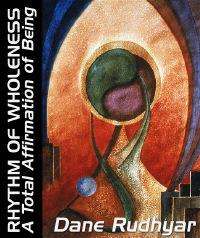 |
| Home | Bio | Art | Music | Literature | Civilization & Culture | Philosophy of Wholeness | Theosophy & Spirituality | Astrology |

RHYTHM OF WHOLENESS A Total Affirmation of Being by Dane Rudhyar, 1983 CONTENTS PROLOGUE PART ONE The Philosophy of Operative Wholeness 1. Prelude to a New Interpretation of Reality 2. The Search for Spiritual Security: The One, the Whole, and Wholeness 3. The Movement of Wholeness PART TWO The Cycle of Being 4. The Structure of the Cycle of Being 5. The Four Crucial Phases of the Cycle of Being 6. The Inevitability of Success and Failure 7. Spirit and Mind PART THREE The Cycle of Man 8. Constitution of Man - The Physical and Psychic Bodies 9. Constitution of Man - The Spiritual Entity and the Higher Mind 10. The Structure and Transformation of the Total Person 11. The Cyclic Process of Spiritual Embodiment PART FOUR In The Spirit of Wholeness 12. The Principle of Holarchy and the Interplay of Horizontal and Vertical Relationships Page 1 Page 2 Page 3 Page 4 Page 5 13. Transpersonal Activity versus Mediumship 14. Rites of Passage EPILOGUE |

CHAPTER TWELVE
The Principle of Holarchy and the Interplay of Horizontal and Vertical Relationships - 5 The formation of groups: Family and peer groups The importance of groups in modern society is increasing. But contemporary theories of group formation and group interactions are dominated by individualistic, egalitarian, and idealistic attitudes. These attitudes also are reflected in the approach taken by modern science for several centuries to explain the development of the universe. From the astrophysical point of view, the universe evolved after an unexplained — and unexplainable — enormous release of energy that almost at once transformed itself into some kind of protomatter. The original space then filled with an immense number of particles which, unorganized and moving at random, yet according to "laws" whose origin also is unexplained, eventually came together, forming increasingly large units. Evolution is therefore the result of a constantly more inclusive aggregation or gradual organization of elements which all operate at the same general level of existence. Evolution is a one-way process. At the sociocultural level it has been glorified as "progress." But can one explain this progress simply on the basis of a more or less fortuitous "coming together" of elements — be they atoms, molecules, or human beings? In the mid-eighteenth century the French-Swiss philosopher Jean Jacques Rousseau took great pains to try to show that primitive societies were formed as the result of a "social contract" in which all the would-be members agreed to follow at least basic rules. Perhaps he was influenced by the event that took place about two hundred years earlier on the Mayflower — the signing of the contract by the Pilgrims who were escaping religious persecution in their native land. However, in the light of what is known of primitive societies and of the gradual emergence of human faculties out of the unconscious depths of animal instincts, Rousseau's concept is senseless. The process of formation of any society is dominated first by biological facts and needs. Only later do the results of the participants' conscious and deliberate interactions become dominant. To a very large extent, the character of the associative relationships that develop through cooperative activity results from the nature of a particular environment which the original settlers did not choose, but to which they were compulsively attracted. Even more incontrovertibly, the same is true of the relationship between newborn babies and their parents. This is a compulsive as well as vertical relationship, in the sense that the parents fundamentally act — or at least should act in all societies operating in a natural manner — not as individuals but as beings charged with the perpetuation of the human species. Through its parents the newborn is related to homo sapiens, first in a strictly biological sense, then at the sociocultural level in terms of the religion and culture to which the parents belong and which it is (or until recently was felt to be) their religious and social duty to perpetuate through their progeny. Therefore, the parent-child relationship should not be considered essentially horizontal. Horizontal relationships begin when siblings are present; but these occur within the theoretically well-defined field of activity constituted by the family. During the twentieth century, there has been constantly increasing stress upon individualism and personal self-expression, even in very young children whose behavior is mostly imitative (or in some cases polarized by distaste, fear, and revolt). As a result the quality of relationships desired within the family group has become confused with the quality of relationships appropriate within the peer groups in which family members participate. Naive, immature, or overly idealistic parents desire to be "pals" with their young and (even more) adolescent children. Parents no longer are able, or even willing, to accept and perform their archetypal functions. Having lost its archetypal character, the family is no longer, or at least not effectively and significantly, the next "greater whole" to which the child belongs. If the child does not learn to grow within this primordial greater whole and does not feel that he or she belongs to it, later the child will encounter difficulty feeling a sense of belongingness to a still greater whole — to the community or nation and eventually to the largest experienceable wholes, humanity and the planet earth. When such patterns of thwarted development pervade an entire society, the only relationships human beings can accept are with peers. These relationships are theoretically horizontal, though in fact they are not always so. Lacking a sense of belonging to an organic whole, modern pseudo-individuals envision peer groups as being formed by the coalescence of more or less randomly formed horizontal relationships (a picture which is reinforced in the United States by the restless, peripatetic nature of American society). This, of course, is the democratic ideal, as it has come to be understood by recent generations for whom all vertical relationships have become suspect. No great difference is recognized between the often oppressive if not tyrannical "verticality" of social relationships (employer-employee, governor-governed, general-private, and so on) and the hierarchical, containing character of the immense series of natural and cosmic wholes. The issue may seem to refer only to social processes and to the place occupied in the modem world by the family and the multitude of peer-groups, unions, clubs, and societies bringing together people who have common interests; but it actually refers to the whole picture human beings make of their destiny and of the future developments of consciousness and activity on earth. This picture radically changes when seen in relation to the "model" of the cycle of being and the concept of holarchy I have presented. The evolution of the earth, humanity, cultures, groups and persons need no longer be interpreted and understood as a one-way aggregation of random contacts operating within the laws of attraction and repulsion (important as these laws are). It can be seen as a two-way process integrating the involution of forms (archetypes) and the evolution of material energy-systems. Separate elements — be they atoms, living organisms, persons, or groups — do not just come together; they are brought together. Pre-existing archetypal patterns of organization gradually bring together material elements — including at the sociocultural level, human beings — into structuring "fields of forces." The relationship between these archetypes and the elements that accept their morphogenetic pressures — albeit for a long time compulsively and instinctively, but eventually consciously — is truly vertical. Such relationships become focused in various ways. Catalytic agents exist in chemistry; at the level of human evolution a similar function is performed by transpersonal agents through whom the archetypal power of formation is able to operate in a mode appropriate to the human (personal or collective) needs that have to be met. The authority vested in a social, political, or religious office derives from the formative potency of the archetypal function the office is intended to perform in the larger operational system to which it belongs. This authority becomes power when used by the office-holder, by the "officiant" in the great ritual of society, business, or of culture — or, in a still broader sense, in the great ritual of the development of human consciousness toward Illumination. Yet if this power is to be used for personal profit and ego-aggrandizement, woe to the user generating such negative karma! While the process of human existence implies vertical and horizontal relationships everywhere and at all times, the two types should not be confused with one another. At least in theory, the horizontal relationships of the great variety of peer-groups dominating our egalitarian society may seem the most common; but these are situations in which a person should consider himself or herself an instrument for the activation of a fundamentally vertical relationship. Nearly every man and woman acts as a channel for the release of the biological power invested in the human species as the greater whole to which they belong, whether they are conscious of belonging and so acting or not. That power uses them; they do not possess it. Whoever becomes a focusing agent for the desired or unwelcomed activity of biological processes of embryonic formation establishes a vertical relationship to the product of this activity — a child. The relationship is potential in the mere fact of the production or presence of reproductive cells in one's body. However, these cells live their own lives. Their production or cyclic release generates powerful biopsychic currents. These currents seek to dominate the consciousness and the activity of the cell-holders — until somehow the consciousness, mind, and will have consummated the long and arduous rite of passage that leads to metabiological being and eventually the Pleroma state. Similarly, but at the level of culture and religion, a person may act as a channel for the release of archetypal ideas. To the extent such a person acts as an agent for humanity (or for a particular section of it) his or her activity is transpersonal. It establishes a vertical relationship with the people who accept the validity of the formulation of the release and are moved and aroused to action by it. When a guru transmits to chelas a current of psychic power generated by a vast collectivity of spiritual entities — who as human beings had found inspiration and transcendent fulfillment in a particular "lineage" — the relationship between the disciple and the guru also is vertical (and usually devotional as well). At the sociocultural level, the relationship between the creative genius (or even the formulator of a new approach revolutionizing collective behavior or business methods) and his or her public tends to be much less focused and more taken for granted. Moreover, as every person today is urged to be "creative" — which usually only means productive in a more or less personality-revealing way — the relationship of student or disciple to "master" has lost the quality it had in Medieval and Renaissance times. When "creativity" is reduced to technical proficiency or special expertise in a field of research, relationship can only be horizontal. But where only horizontal relationships are accepted by "rational" minds, an inevitable compensation occurs. An irrational kind of activity fascinates an ever increasing number of persons; "mediums" multiply. Transpersonal activity finds in mediumship a shadowy twin; and the twain are not easily distinguished. By permission of Leyla Rudhyar Hill Copyright © 1983 by Dane Rudhyar All Rights Reserved.  Web design and all data, text and graphics appearing on this site are protected by US and International Copyright and are not to be reproduced, distributed, circulated, offered for sale, or given away, in any form, by any means, electronic or conventional. See Notices for full copyright statement and conditions of use. Web design copyright © 2000-2004 by Michael R. Meyer. All Rights Reserved. |
 |